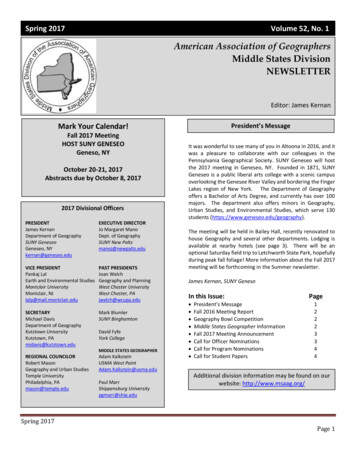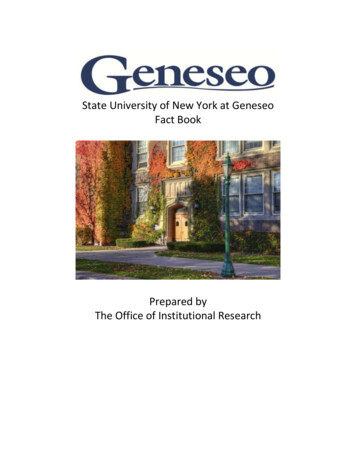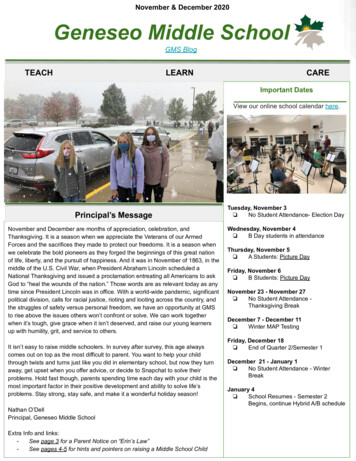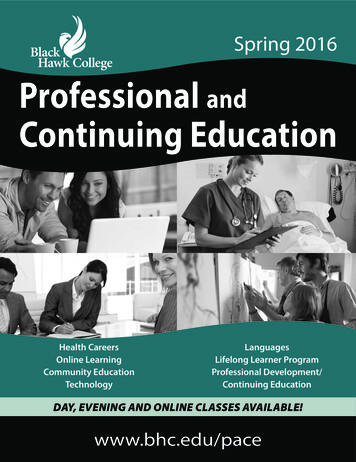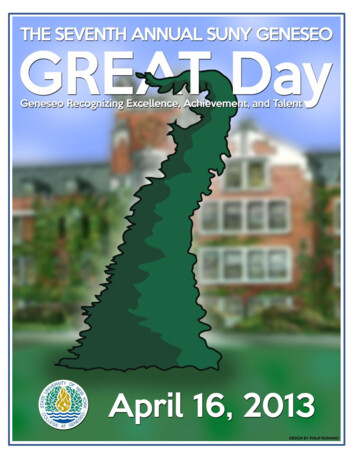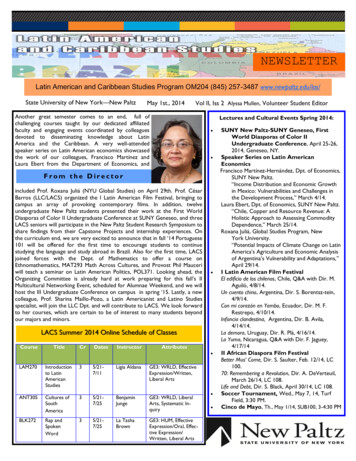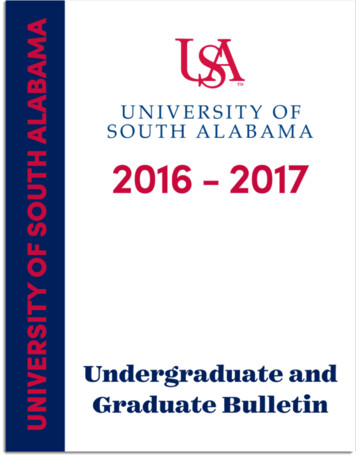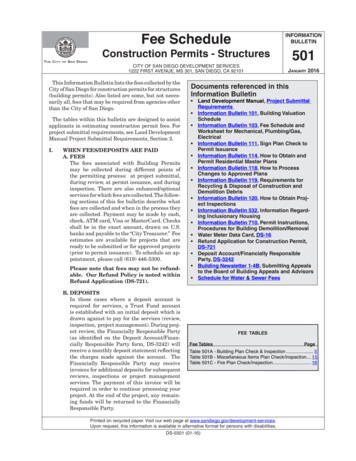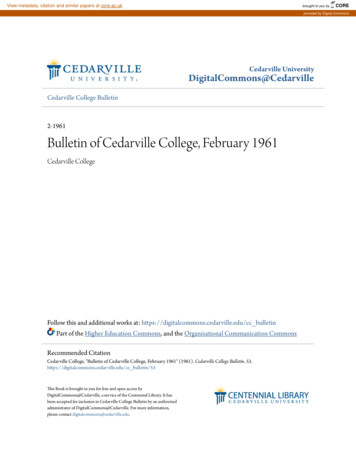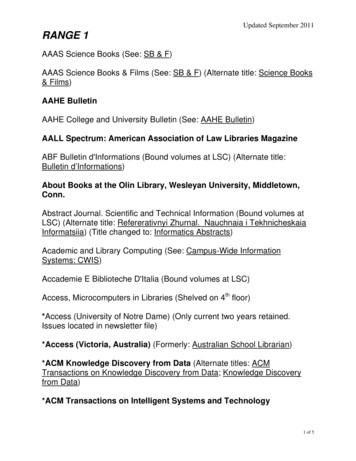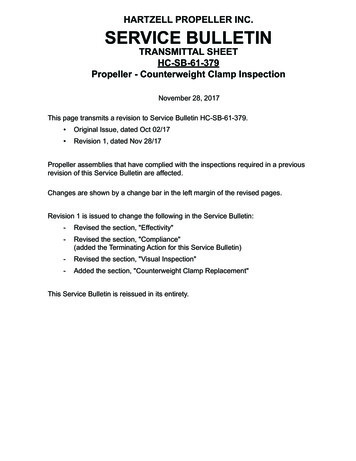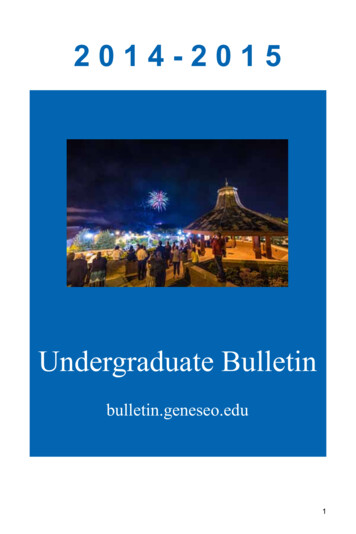
Transcription
2014-2015Undergraduate Bulletinbulletin.geneseo.edu1
State University of New York at Geneseo2014-2015 Undergraduate BulletinTable of ContentsGeneseo’s Mission2Accreditation6Geneseo’s Statement on Diversity andCommunity6Officers of the CollegeAdmissions and EnrollmentCollege ExpensesOffice of Student AccountsDivision of Student and Campus LifeCareer Development andStudentEmploymentCenter for CommunityCollege Union and ActivitiesIntercollegiate Athletics andRecreationResidence LifeUniversity Police DepartmentCampus Auxiliary Services (CAS)Alumni AssociationThe Geneseo FoundationAcademic OrganizationsAcademic ServicesMilne LibraryTeaching and Learning CenterComputing and InformationTechnologyAccess Opportunity Programs(AOP)Office of Disability ServicesCampus Scheduling andSpecial EventsAcademic PoliciesAcademic AdvisorsMandatory AdvisementRegistrationPrerequisitesAttendance at the Beginning of theSemesterCross-Registration with RochesterArea 2929292929Reserve Officers’ TrainingCorps (ROTC)Enrolling in Graduate CoursesAuditing CoursesDropping and Adding CoursesWithdrawing from Courses3030303030Declaring Majors and MinorsChanging Majors and ProgramsInternshipsStudying at Other CollegesStudy AbroadLeaves of AbsenceWithdrawing from the College31313132323333Academic Standards, Dismissal,and ProbationSemester HonorsRepeat Course PolicyMultiple MajorsClassroom PoliciesGraduationSummer Sessions3336384141434545Baccalaureate Degree ProgramsRequirements for Baccalaureate DegreePrograms47The College Curriculum48Program Outline48Scholarships and AwardsAcademic Programs5361Academic Minors360Pre-professional Advisory Programs375Student Code of ConductOther College Guidelines378378Faculty of the College38329301
Geneseo’s MissionThe State University of New York at Geneseo, nationally recognized as a center of excellencein undergraduate education, is a public liberal arts college with selected professional andmaster’s level programs. It combines a rigorous curriculum, transformational learningexperiences, and a rich co-curricular life to create a learning-centered environment. The entirecollege community works together to develop socially responsible citizens with skills andvalues important to the pursuit of an enriched life and success in the world.Planning Goals and ValuesGeneseo is distinguished by one overriding purpose: to achieve excellence in higher education.The College realizes this through a spirit of cooperation and collaboration among all membersof the community.Geneseo ValuesExcellence, and upholds high standards for intellectual inquiry and scholarly achievement;Innovation, and affirms a spirit of exploration that fosters continued excellence;Community, and embraces the educational aspirations and interests that its members share;Diversity, and respects the unique contributions of each individual to the campus community;Integrity, and promotes the development of ethical citizens;Service to society, and models the qualities it seeks to develop in its students;Tradition, and celebrates its long history of collaborative, learning-centered education.Planning Goals Provide every student the highest quality education through a rigorous, challenging,and active learning experience in close working relationships with faculty and staff thatencourages intellectual engagement and personal growth. Recruit, support, and foster the development of a diverse community of outstandingstudents, faculty, and staff. Enrich the collegiate experience by strengthening the integration between curricularand co-curricular programs. Cultivate relationships between the College and wider community that support Collegeprograms and serve the community. Expand funding for institutional priorities and initiatives through public and privatesupport, grants, and entrepreneurial activities. Promote institutional effectiveness through ongoing assessment in every program.Provide a high quality physical environment and outstanding services, facilities, equipment, and technology.Historical BackgroundSUNY Geneseo, one of thirteen university colleges within the State University of New Yorksystem, was established by an act of the New York State Legislature in 1867 as the GeneseoNormal and Training School and opened September 13, 1871. Curricular offerings includedelementary English, advanced English, and classical studies.In the early 1900s, the curriculum was reorganized to require two years of professional study,and admission was restricted to high school graduates. In 1922, the programs were extendedto three years, and in 1938, to four years. In 1942, the College was granted authority to conferbaccalaureate degrees in all its curricula. Basic teacher training programs were expanded2
to include preparations for teacher-librarians, teachers of children with special needs, andspeech pathologists. Teacher education continues to be a strong component of the College’sprograms.Geneseo became an original campus of the new State University of New York system at SUNY’sinception in 1948. During the next three decades the College developed strong liberal arts andsciences programs and added several professional curricula to its offerings. The first master’sdegrees were awarded in 1951. In 1962, the teachers colleges of the State University becameColleges of Arts and Sciences. Geneseo’s four-year degree programs in arts and scienceswere implemented in 1964. Since then, the School of Business was established and majorshave been added in such areas as biochemistry, and international relations. The College nowoffers more than 50 degree programs in a wide variety of disciplines. Cooperative programshave been developed in several fields with other institutions, including 3-2 engineering, 3-4dental, and 3-2 and 4-1 MBA programs. The College’s commitment to providing a broadbased liberal arts education was confirmed in 1980 with the establishment of a requiredcore curriculum in natural sciences and mathematics, social sciences, humanities, and finearts. Further revision in 1999 added critical writing, a quantitative requirement and foreignlanguage. The College continues to improve and upgrade its curriculum through regularreview and assessment. The strength of the liberal arts program was recognized in 2003 withapproval for the installation of a Phi Beta Kappa chapter on campus. The chapter inductedits first class in Spring, 2004.Since 1994, SUNY Geneseo has been a member of The Council of Public Liberal Arts Colleges(COPLAC), an alliance of high quality, public liberal arts institutions. Founded in 1987,COPLAC serves to promote excellent undergraduate education in the liberal arts tradition;the development of effective teaching and learning communities; and the expansion of accessto public undergraduate liberal arts education of the highest caliber. COPLAC’s membershipcurrently consists of twenty-five public liberal arts colleges and universities who are committedto providing and advocating for the superlative, life-enhancing undergraduate educationnormally associated with small independent colleges. COPLAC also provides leadershipin defining and modeling “best practice” in undergraduate education and promoting thequalities cultivated by outstanding student-centered liberal arts colleges.The State University of New York at Geneseo has evolved dramatically over its 135-yearhistory into a highly selective public liberal arts college, which is nationally recognized forthe quality of education it offers.LocaleGeneseo is located in the heart of the Genesee Valley, noted for its scenic beauty. Rich inNative American history and legend, and the former site of many Native American villages,the Genesee Valley was the western limit of the territory of the Senecas.Geneseo is an ideal college town, with long-established traditions of friendship and culture.Both the village - one of 24 communities nationwide to be recognized as a National HistoricLandmark - and the campus’s ivy-covered brick buildings reflect a traditional collegeatmosphere.The College is readily accessible. Rochester, which is 30 miles to the north, is served byAmtrak and several airlines. Bus service connects Geneseo with Rochester and with manytowns and cities in surrounding counties. LATS (Livingston Area Transportation Service)provides regular daily shuttle service around College and to local commercial areas, as wellas weekend service to Rochester designed for Geneseo students.Geneseo’s 220-acre campus is located just a few minutes off Interstate Route 390, whichconnects with the New York State Thruway (Exit 46) in Rochester. US Route 20A, and NYSRoutes 63 and 39, all pass through the village of Geneseo near the campus.Roemer ArboretumThe Roemer Arboretum was founded in 1990 through an endowed gift to the GeneseoFoundation by Spencer J. Roemer, College benefactor and former director of admissions. Itconsists of 20 acres, located on the south campus of the College, south of the residence hall3
and between Routes 20A/39 and Route 63. Visitors enter from Routes 20A/39 through theSouth Campus parking lot J.Mr. Roemer expressed the wish that the area be used as a living outdoor classroom byCollege faculty and students to preserve and enhance the beauty of the Genesee Valley. Thearboretum is open, free of charge, from dawn to dusk. Visitors are encouraged to walk alongthe paths, admire the beauty of the Genesee Valley, inspect the variety of trees and plants,relax and enjoy the view from the gazebo and benches. Future plans include additionalplantings indigenous to the northeastern area of the United States.GalleriesThe Bertha V.B. Lederer Gallery in William A. Brodie Hall presents both contemporary andhistoric rotating exhibitions including works by local, regional and national artists. The BridgeGallery, a unique space bridging two wings of Brodie Hall exhibits art work by Geneseostudents and the Kinetic Gallery in the Robert W. MacVittie College Union exhibits workby students and local artists.The Lockhart Gallery is named for Dr. James and Julia Lockhart and their family. The galleryis in the McClellan House, an historic home at 26 Main Street built in 1825, and named tohonor the late Robert and Jeanette McClellan and their family. The renovation of McClellanhouse, in 2001, was made possible through the collaborative efforts of the College and theGeneseo community. Campus Auxiliary Services are the current managers of McClellanHouse. More information on the galleries may be found at http://geneseo.edu/galleriesBuildings and FacilitiesThe Geneseo campus is characterized by its picturesque setting overlooking the meanderingGenesee River and by its attractive buildings combining brick and limestone in collegiateGothic and functional styles. A state-of-the-art fiber optic computer network connects allacademic and administrative buildings and residence halls. A wireless network is availablein all academic buildings and surrounding outdoor areas.James B. Welles Hall, which houses several academic departments and college classrooms wasoriginally a “demonstration school” and, later, the elementary school for the Geneseo CentralSchool District. Lockers and some fixtures remain as charming reminders of that history.Bertha P. Fraser Hall connects Welles and Sturges Halls and houses faculty offices andclassrooms. Austin W. Erwin Hall is one of four buildings fronting the College Green on theupper quadrangle. The new Integrated Science Center also fronts the College Green and wasopened Fall, 2006. Along with Robert A. Greene Hall, this 102,000-square-foot building isdesigned for interdisciplinary collaboration and to support Geneseo’s strong undergraduateresearch program. The departmental offices for Biology, Chemistry, Geology and Physicsare housed in the Integrated Science Center as well as cutting-edge facilities and equipmentfor science education, research, and connections with community biotechnical and chemicalanalysis companies. Connected to the Integrated Science Center is Newton Hall, containingclassrooms and complete multi-media communication facilities.Guy A. Bailey Hall honors a nationally known biologist who served as chair of the sciences atGeneseo. Bailey Hall now houses the departments of Anthropology, Geography, Psychologyand Sociology.The William J. and John M. Milne Library, just off the College Green and overlooking the valley,is widely recognized for its innovative use of space and service orientation to students andfaculty. In addition to traditional stacks, reference desk, and an award-winning interlibraryloan department, it includes space for group work, high tech classrooms, computing facilities,the Teaching and Learning Center, the ESOL (English for Speakers of Other Languages)Center, the Center for Academic Excellence, and Books & Bytes Café.William A. Brodie Hall, designed by distinguished architect and former apprentice to FrankLloyd Wright, Edgar Tafel, houses three departments of fine and performing arts, andincludes the Austin and Sinclair theaters, music rooms, dance studios, and the Lederer andBridge art galleries.South Hall, which opened in 1995, houses the Schools of Business and Education, and thedepartment of Mathematics, as well as the College’s main computing facilities (including a4
two-level general access computer laboratory). The three-story structure contains state-of-theart teaching facilities, including specialized classrooms developed to meet the programmaticneeds of the four academic departments.Residence halls are grouped into the South Village, the Central Village, and the North Villageto encourage a sense of community and interconnections among residents. The SouthVillage consists of Nassau, Niagara, Onondaga, Suffolk, and Wayne halls, along with RedJacket Dining Hall. Many of these halls are corridor-style, popular with first-year students.Saratoga Terrace, townhouse style campus housing for two hundred upper-level students,links the South Village with central campus. The complex includes a Commons buildingwith laundry facilities and group meeting space. The Central Village is comprised of Jones,Livingston, Monroe, and Steuben halls and is close to Mary Jemison Dining Hall. Monroehall’s 2013 renovation is certified to gold LEED standards and it boasts geo-thermal heatingand rain-water harvesting. The North Village, where Letchworth Dining Hall will reopenin Fall 2014, includes Allegany, Erie, Genesee, Ontatio, Putnam, Seneca, and Wyoming halls.The suite-style halls in the North Village provide flexible group-living spaces, popular withupper-level students. Putnam Hall, connecting Allegany and Wyoming halls, won a regionalaward for excellence of design when it opened in Fall 2004. Seneca hall, new in 2009, is anarchitectural complement to Putnam; this 84-bed residence connects Genesee and Ontario halls.Residence halls provide service and reception areas as well as student lounges and studyspaces. Each room has one cable TV connection in addition to two hard-wired internetports and wireless internet access. Student rooms do not include private phones, but sharedtelephones are provided in each hallway. Every residence hall room is equipped with firesprinklers and smoke alarms. Carbon Monoxide (CO) detectors are installed in bedroomsand common spaces on any level in residence halls where there is gas-fired equipment.Every residence hall building includes laundry facilities and kitchenettes. All residencehall exterior doors are locked 24 hours a day with a card-access security system; residentialstudents enter their halls with their Geneseo ID cards.The campus meal plan offers many dining options. Centrally located Mary Jemison DiningHall is a state-of-the-art dining food court offering a wide variety of choices. In addition, theRed Jacket and Letchworth dining halls offer all-you-can-eat value meals seven days a weekfor lunch and dinner. Other options include a ChowHound food truck, Southside Café andUncle Vito’s Pizza Delivery. The MacVittie College Union features a Starbucks Cafe anda Fusion Market, which blends Mediterranean and Southeast Asian cisine, as well as freshfruits and vegetables. Milne Library hosts Books & Bytes cafe. The student meal plan mayalso be used at the Big Tree Inn, a landmark fine dining establishment and inn located onMain Street in the village of Geneseo.Student Health and Counseling Services are located in the Lauderdale Health Center. Thisbuilding houses medical equipment and supplies necessary for the health and counselingneeds of students and is staffed by full-time College medical personnel.The Carl L. Schrader Health and Physical Education Building is one of the facilities designed toprovide for the health, physical education, and recreational needs of the College community.This building has a double gymnasium, racquetball courts, dance studio, individual exerciseareas, and other facilities for instructional and extracurricular programs. It also houses theoffices of Residence Living, University Police, and Facilities Planning.The Myrtle Merritt Athletic Center is connected to Schrader Building, and contains KuhlGymnasium, Wilson Ice Arena, a swimming and diving pool, a complete fitness center withworkout equipment, a wrestling room, four squash courts, and coaches’ offices.A large proportion of the campus adjacent to the health and physical education complex hasbeen developed, according to a comprehensive plan, as an outdoor athletic and recreationalarea. Raschi Field for softball, and space for archery, golf, lacrosse, soccer, field hockey, andtennis are located in this area. Moench Field serves the needs of the track and field programs.The Robert W. MacVittie College Union is the hub of recreational and cultural student activitieson the campus. It includes: student organization and staff offices; lounges, meeting rooms,recreation, study areas; Starbucks and Fusion Market; campus bookstore; ballroom; studentart gallery; computer and project area with photocopiers; the campus mail facility; ATMmachine, the Geneseo Federal Credit Union; MOSAIC (Multicultural Organization Spacefor Activities, Inclusion, and Collaboration); GOLD leadership center. Student organizationmailboxes, package claim, and meeting room key sign-outs are provided. The Ticket Office5
sells tickets for all performing arts events on campus. Further information is available athttp://union.geneseo.edu.AccreditationThe College is accredited by the Middle States Association of Secondary Schools and Colleges.Other accreditations or certifications include those from the American Chemical Society,the Association to Advance Collegiate Schools of Business, and the National Council forAccreditation of Teacher Education.Geneseo’s Statement on Diversity and CommunityGeneseo holds among its core values the ideals of community and diversity. Our communityis defined as a group of faculty, students and staff who live and work together at Geneseobecause they share common goals that are based on the ideals of higher education rootedin the liberal arts.Although they share common goals, the members of the Geneseo community also differin many ways. Diversity at Geneseo is defined in part as differences in individuals that aremanifested in their race, ethnicity, national origin, language heritage, world-view, religion,gender, sexual orientation, class, physical ability, learning style, geographic background,mental health, age, and relationship status.Geneseo recognizes that the individuals who make up our community bring to it uniqueperspectives and knowledge that contribute to its richness and vibrancy. Because Geneseoalso holds educational excellence among its core values, it recognizes that its progress as acommunity toward such excellence is predicated on its ability to embrace both the diversityof its members and the vigorous exchange of their ideas.Geneseo calls all members of our community to share responsibility for the ongoing work ofcontinually recreating a sense of inclusion, belonging, and empowerment, so that togetherwe will achieve our individual and collective aims, and experience the intellectual liberationthat is at the heart of the educational enterprise.Approved by the College Senate October 10, 2003.Sustainability StatementSUNY Geneseo calls upon all members of our community to embrace sustainability as acore value, including a commitment to its constitutive principles of ecological, social, andeconomic justice. We recognize the critical role of higher education in creating a sustainablesociety.Through teaching, research, service, and institutional conduct we strive to nurturethe values, skills and knowledge necessary to sustain and enhance human and non-humanlife on the planet.The college understands that sustainability is a process of building support for societal andintergenerational equity and a shared sense of responsibility for the ethical stewardship ofour social and natural environment. We endorse the broad scientific consensus that humandemands on the planet threaten the ecological, social and economic resources upon whichour global society depends.As a public liberal arts college, we seek solutions to these increasingly complex, interdisciplinaryproblems that are consistent with our shared values and ideals. Recognizing that the promotionof sustainability is central to the mission of the college, SUNY Geneseo calls upon its faculty,students and staff to foster a culture of sustainable and responsible citizenship on campus.By minimizing the environmental impact of our institutional operations and integratingthe principles of sustainability throughout our academic disciplines and co-curricular lifewe can begin to realize a more profound and enduring form of prosperity for current andfuture generations.6
Officers of the CollegeCAROL S. LONG Interim President. B.A., Pomona College; M.A., Ph.D., NorthwesternUniversity; 2009.DAVID F. GORDON Interim Provost and Vice President for Academic Affairs. B.A., Grinnell College; M.A., Ph.D., University of Chicago; 1978.ROBERT A. BONFIGLIO Vice President for Student and Campus Life. B.A., Stonehill College; M.Phil., Columbia University; M.A., Ed.D., Teachers College, Columbia University; 1999.WILLIAM H. BROWER III Vice President for College Advancement. B.A., Hamilton; 2012.JAMES MILROY Vice President for Administration and Finance. B.A., State University ofNew York, Geneseo; PhD., University of Buffalo; 2006.MEAGHAN L. ARENA Vice President for Enrollment Management. B.A., University ofDelaware; M.Ed., Cambridge College; Ed.D., , Northeastern University; 2014.Geneseo College CouncilSUNY Board of TrusteesRobert D. Wayland-Smith, ChairH. Carl McCall, ChairIris BanisterJoseph BelluckRobert A. HeinemanEric CorngoldA. Gidget HopfHenrik DulleaJudith HunterRonald EhrenbergEddie Lee, Alumni RepresentativeAngelo FattaMary LuckernTina GoodJames McLean, Faculty RepresentativeEunice A. LewinHarrison Dole, Student RepresentativeMarshall LichtmanChristian Valentino, EsqLori MouldCarol S. Long, Ex-OfficioJohn MuradPeter KnuepferLinda SanfordRichard SocaridesCarl SpielvogelCary StallerLawrence Waldman7
Admissions and Enrollmentadmissions.geneseo.eduEnrollmentThe planned enrollment for the next two academic years is approximately 5000 full-timeundergraduate students. An estimated 100 part-time students are also expected to enroll.Student RetentionThe College monitors student retention rates for each entering class using a six-year cohortsurvival technique. The latest figures show that nearly 81% of the freshman class completebaccalaureate degrees on time. Specific details on retention rates are available from the Officeof Institutional Research, 222 Erwin Hall.AdmissionsAdmission to the College is based upon the academic and personal qualifications of applicantsand is granted without regard to age, color, disability, marital status, national origin, sex,sexual orientation, religion, race, or status as a disabled or Vietnam-era veteran. The candidateselection process is highly competitive; the College attempts to identify those individualswho will most benefit from the curricular and co-curricular programs offered.Application ProceduresApplications for admission to the College may be accessed online at either commonapp.org or suny.edu/applysuny. Electronic applications are preferred. Applications should becompleted by January 1 for fall semesters and October 15 for spring semesters. Candidatesare encouraged to apply early to assure full consideration.InterviewsPersonal interviews are not required for admission. However, for prospective students andtheir families who have questions and would like to speak to an admissions counselor, theOffice of Admissions schedules appointments between 8:30 a.m. and 3:30 p.m., Mondaythrough Friday. Campus tours and information sessions are conducted daily and on mostSaturdays during the year. Prospective applicants are encouraged to make appointments forinterviews and tours at least two days in advance of their visit to campus. Appointments maybe scheduled by calling the Admissions Office at (585) 245-5571 or (866) 245-5211. Visitorsmay also schedule themselves for a tour on the Tour and Events Calendar on the Admissionswebsite at go.geneseo.edu/tour.Freshman AdmissionApplicants for admission to the freshman class must present official copies of their high schooltranscripts showing all courses completed and grades earned. High school graduation orcompletion of a high school equivalency diploma is a minimum requirement for admissionconsideration.Candidates must also present the results of either the Scholastic Aptitude Test (SAT I) of theCollege Entrance Examination Board or the Assessment of the American College TestingProgram (ACT). The Committee on Admissions will give preference to the strongestperformance when multiple test scores are submitted.The Committee on Admissions considers a number of factors when selecting students forthe freshman class, including the rigor of each candidate’s academic program, performanceon examinations, improvement in performance, rank in class, unweighted grade pointaverage, a written essay, letters of recommendation, extracurricular accomplishments, andscores from one of the national college testing programs described above. Candidates foradmission to fall semesters are notified of admissions decisions on March 1. Decisions forspring semesters are released after November 1.Early Admission ProgramThe Early Admission program is designed to permit talented and highly motivated studentswho have completed the junior year of high school, and who have the support of theirhigh school counselor or principal, to enroll at Geneseo as fully-matriculated freshmenand apply their first year of college studies toward a high school diploma. For information8
about application procedures and selection criteria, prospective students should contact theDirector of Admissions.Early Decision ProgramGeneseo College participates in a first-choice, early decision plan. The purpose of this programis to secure positions in the freshman class for superior candidates who have decided uponGeneseo as their first-choice college and who have academic credentials that would placethem in the most preferred category. Candidates may apply to only one college throughearly decision, but may apply to more than one college through regular decision. However,if admitted under the early decision program, students agree to attend Geneseo and towithdraw all other applications. To apply for early decision at Geneseo, candidates musthave the following information on file in the Admissions Office no later than November 15:1.2.3.4.5.An application. (The College accepts either the common application or the SUNYapplication);An official high school transcript and results of either the Scholastic Aptitude Test (SATI) or American College Test (ACT);All required supplemental information;A letter of recommendation from a teacher;A signed, early-decision contract with a handwritten Statement of Commitment. Thecontract must be signed by the student and the parent or guardian.Early decision candidates are advised of the Admissions Committee’s decision by midDecember.Special Talent AdmissionSpecial consideration may be given to candidates who present evidence of a talent orproficiency in athletics, music, theater, or another area that would enable them to makea special contribution to enriching the life of the campus. The Committee on Admissionswill consider an individual’s special talent in conjunction with standard selection criteria.Additional information may be obtained from the Director of Admissions.International Student AdmissionsThe College invites applications from students from other countries. Because the College offerslimited instruction in English as a foreign language, candidates must demonstrate competencein both written and spoken English. In most cases, candidates must submit the scores fromthe TOEFL or the IELTS examination along with a complete record of their secondary schooland college studies. International students must submit a completed application with allrequired supporting documents by June 1 for the Fall term and November 1 for Spring .International Student and Scholar Services OfficeThe International Student and Scholar Services Office, located in Erwin 218, is responsiblefor the recruitment, credential evaluation and admission of students from other countries.Prospective students considering undergraduate admission who are not U.S. citizens orimmigrants should contact the Director of International Student and Scholar Services forappropriate application materials.In addition to its admissions responsibilities, the International Student and Scholar ServicesOffice issues the federal documents required for prospective students to obtain student visasfor entry to the United States and enrollment at the university. The office acts as the liais
1 State University of New York at Geneseo 2014-2015 Undergraduate Bulletin Table of Contents Geneseo's Mission 2 Accreditation 6 Geneseo's Statement on Diversity and Community
